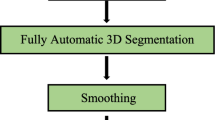Abstract
Data-centric AI is a discipline that focuses on improving the quality and relevance of data used to train AI models. It is a shift from the traditional model-centric approach, which focuses on improving the performance of AI models by tuning the model parameters. This paper presents a data-centric approach for segmenting the aortic vessel tree. The proposed approach consists of a preprocessing pipeline that performs histogram matching and sigmoid windowing, followed by a series of 3D segmentation models. The preprocessing pipeline is designed to improve the contrast and visibility of the vessels in the images, which makes the task easier for the segmentation models. There are three stages of UNet networks each of which performs a different level of segmentation where the result progresses from coarse to fine segmentation. We trained and evaluated the approach to the segmentation of the aorta challenge SEG.A. 2023 dataset. Our approach achieved a Dice Similarity Score of 0.92 \( \pm \) 0.02 and a Hausdorff Distance (95%) of 6.3 mm \( \pm \) 5.72. Our approach produced a segmentation pipeline that accurately captures the complex structure of the aortic vessel tree and is resistant to changes in noise level, contrast, and geometry.
Access this chapter
Tax calculation will be finalised at checkout
Purchases are for personal use only
Similar content being viewed by others
References
Segmentation of the Aorta Challenge: Image variations (2023). https://multicenteraorta.grand-challenge.org/ct-image-variations/
Fantazzini, A., et al.: 3d automatic segmentation of aortic computed tomography angiography combining multi-view 2d convolutional neural networks. Cardiovasc. Eng. Technol. 11(5), 576–586 (2020). https://doi.org/10.1007/s13239-020-00481-z
Huttenlocher, D., Klanderman, G., Rucklidge, W.: Comparing images using the Hausdorff distance. IEEE Trans. Pattern Anal. Mach. Intell. 15(9), 850–863 (1993). https://doi.org/10.1109/34.232073
**, Y., et al.: AI-based aortic vessel tree segmentation for cardiovascular diseases treatment: status quo. ar**v preprint ar**v:2108.02998 (2021)
Lyu, T., et al.: Dissected aorta segmentation using convolutional neural networks. Comput. Methods Programs Biomed. 211, 106417 (2021). https://doi.org/10.1016/j.cmpb.2021.106417. https://www.sciencedirect.com/science/article/pii/S0169260721004910
Maier-Hein, L., et al.: Bias: transparent reporting of biomedical image analysis challenges. Med. Image Anal. 66, 101796 (2020). https://doi.org/10.1016/j.media.2020.101796. https://www.sciencedirect.com/science/article/pii/S1361841520301602
Melito, G.: Sensitivity analysis for model optimization and calibration in type B aortic dissection. Ph.D. thesis, Graz University of Technology (90000), April 2022
Melito, G., Jafarinia, A., Hochrainer, T., Ellermann, K.: Sensitivity analysis of a phenomenological thrombosis model and growth rate characterisation. J. Biomed. Eng. Biosci. 7, 31–40 (2020). https://doi.org/10.11159/jbeb.2020.004
Melito, G.M., et al.: Sensitivity analysis study on the effect of the fluid mechanics assumptions for the computation of electrical conductivity of flowing human blood. Reliab. Eng. Syst. Safety 213, 107663 (2021). https://doi.org/10.1016/j.ress.2021.107663. https://www.sciencedirect.com/science/article/pii/S0951832021002040
Noothout, J.M.H., de Vos, B.D., Wolterink, J.M., Isgum, I.: Automatic segmentation of thoracic aorta segments in low-dose chest CT. CoRR abs/1810.05727 (2018). http://arxiv.org/abs/1810.05727
Pepe, A., et al.: Detection, segmentation, simulation and visualization of aortic dissections: a review. Med. Image Anal. 65, 101773 (2020). https://doi.org/10.1016/j.media.2020.101773. https://www.sciencedirect.com/science/article/pii/S1361841520301377
Pielawski, N., Wählby, C.: Introducing Hann windows for reducing edge-effects in patch-based image segmentation. PLOS ONE 15(3), 1–11 (2020). https://doi.org/10.1371/journal.pone.0229839
Pérez-García, F., Sparks, R., Ourselin, S.: Torchio: a python library for efficient loading, preprocessing, augmentation and patch-based sampling of medical images in deep learning. Comput. Methods Programs Biomed. 208, 106236 (2021). https://doi.org/10.1016/j.cmpb.2021.106236. https://www.sciencedirect.com/science/article/pii/S0169260721003102
Radiology, G.: Large vessels, July 2019. https://radiologykey.com/large-vessels/
Radl, L., et al.: AVT: multicenter aortic vessel tree CTA dataset collection with ground truth segmentation masks. Data Brief 40, 107801 (2022). https://doi.org/10.1016/j.dib.2022.107801. https://www.sciencedirect.com/science/article/pii/S2352340922000130
Ronneberger, O., Fischer, P., Brox, T.: U-Net: convolutional networks for biomedical image segmentation. CoRR abs/1505.04597 (2015). http://arxiv.org/abs/1505.04597
Shit, S., et al.: clDice-a novel topology-preserving loss function for tubular structure segmentation. In: Proceedings of the IEEE/CVF Conference on Computer Vision and Pattern Recognition, pp. 16560–16569 (2021)
Wang, H.J., et al.: Automated 3d segmentation of the aorta and pulmonary artery on non-contrast-enhanced chest computed tomography images in lung cancer patients. Diagnostics 12(4) (2022). https://doi.org/10.3390/diagnostics12040967. https://www.mdpi.com/2075-4418/12/4/967
Zou, K.H., et al.: Statistical validation of image segmentation quality based on a spatial overlap index. Acad. Radiol. 11(2), 178–189 (2004)
Author information
Authors and Affiliations
Corresponding author
Editor information
Editors and Affiliations
Rights and permissions
Copyright information
© 2024 The Author(s), under exclusive license to Springer Nature Switzerland AG
About this paper
Cite this paper
El-Ghotni, A., Nabil, M., El-Kady, H., Ayyad, A., Nasr, A. (2024). A Data-Centric Approach for Segmenting the Aortic Vessel Tree: A Solution to SEG.A. Challenge 2023 Segmentation Task. In: Pepe, A., Melito, G.M., Egger, J. (eds) Segmentation of the Aorta. Towards the Automatic Segmentation, Modeling, and Meshing of the Aortic Vessel Tree from Multicenter Acquisition. SEGA 2023. Lecture Notes in Computer Science, vol 14539. Springer, Cham. https://doi.org/10.1007/978-3-031-53241-2_3
Download citation
DOI: https://doi.org/10.1007/978-3-031-53241-2_3
Published:
Publisher Name: Springer, Cham
Print ISBN: 978-3-031-53240-5
Online ISBN: 978-3-031-53241-2
eBook Packages: Computer ScienceComputer Science (R0)





